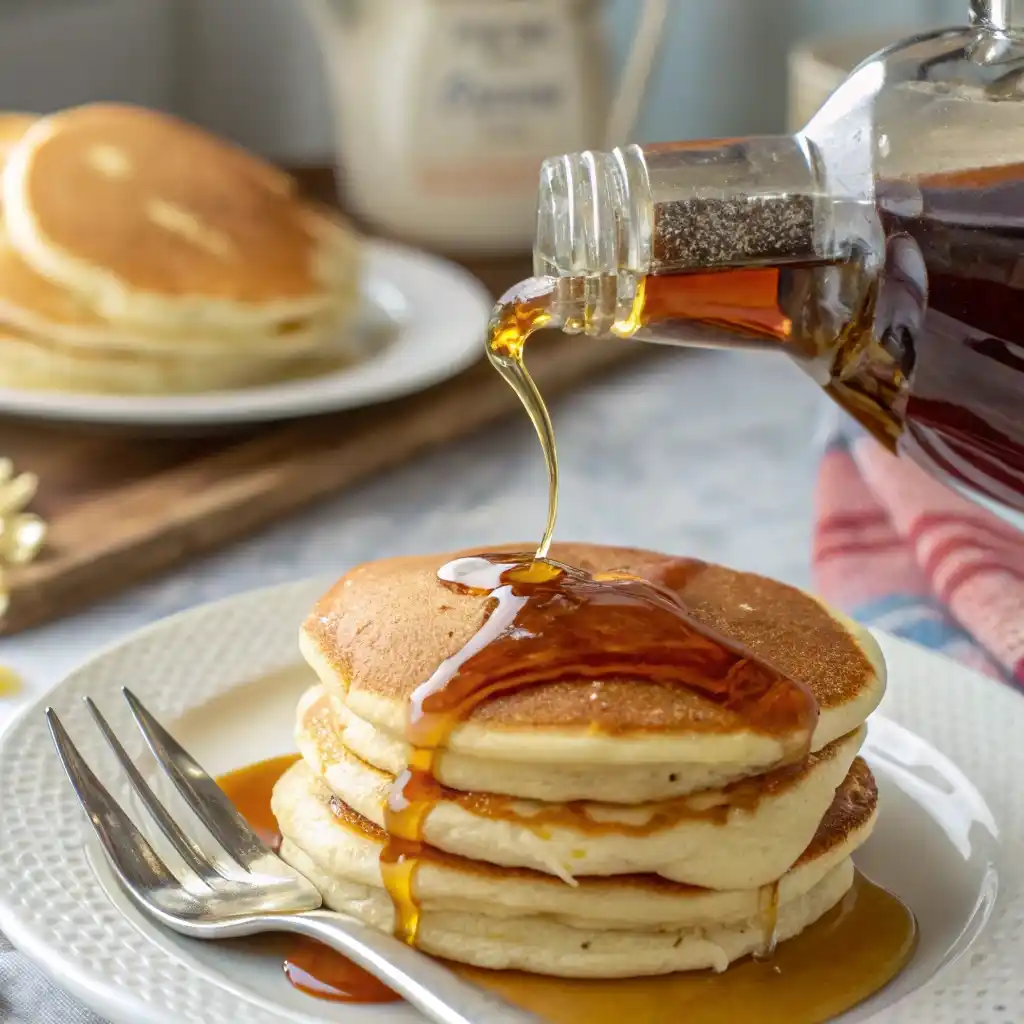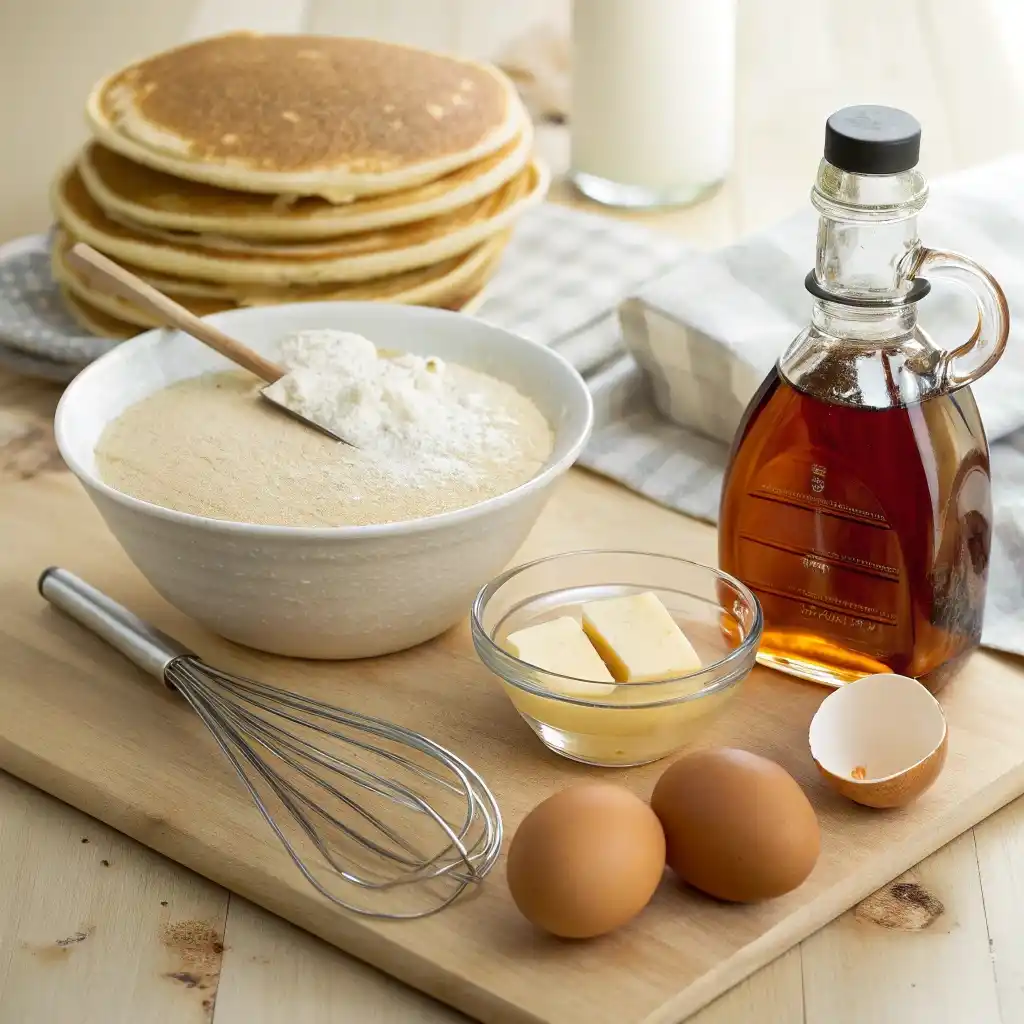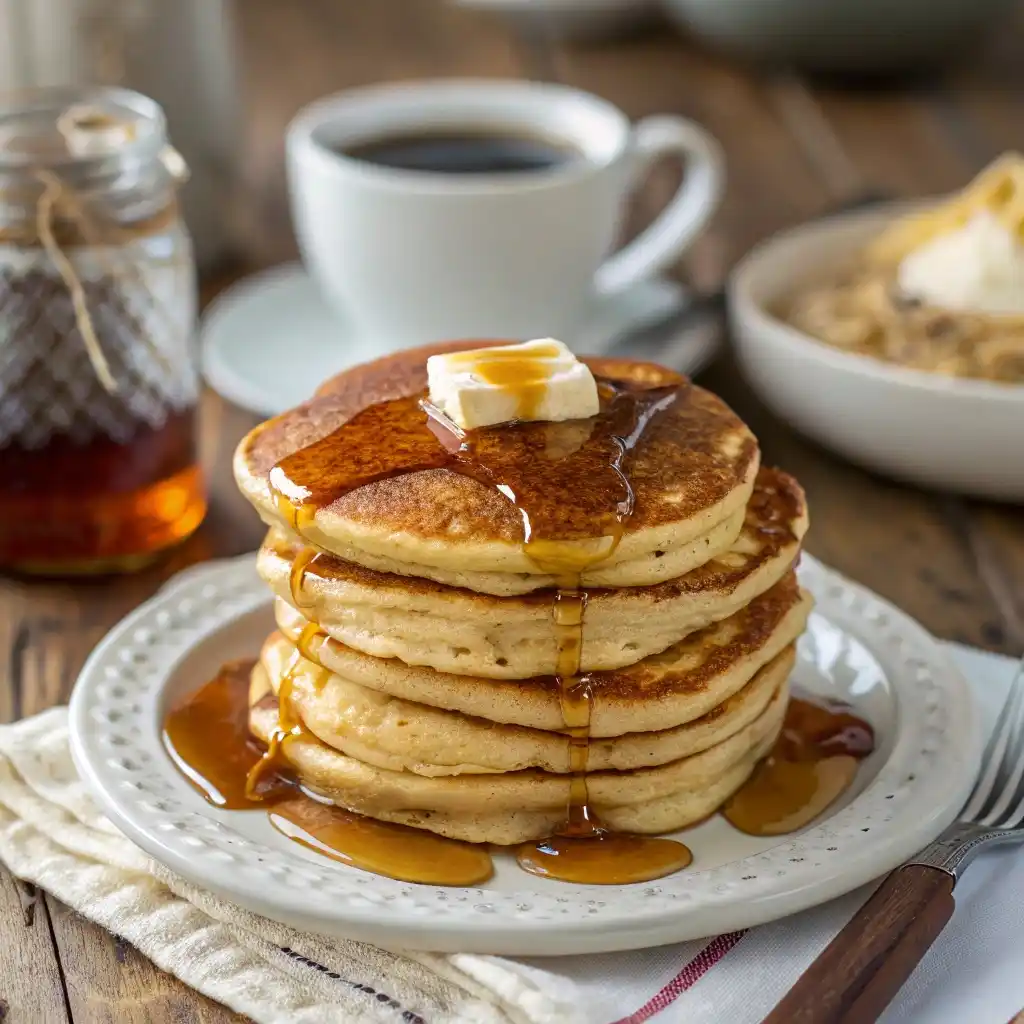Few culinary combinations are as iconic as maple syrup and pancakes. This duo has graced breakfast tables for generations, celebrated for its perfect balance of sweet and savoury flavours. Whether you’re indulging in a weekend brunch or a quick weekday treat, maple syrup elevates pancakes into an irresistible breakfast experience.

The History of Maple Syrup
Origins of Maple Syrup
Maple syrup has its roots in Indigenous North American traditions, where Native peoples discovered the process of tapping sugar maple trees to collect sap. They boiled the sap to create the golden syrup we know today.
Indigenous Traditions and Its Spread Globally
The use of maple syrup spread after early European settlers learned these techniques. Over time, it became a key ingredient in North American cuisine and an export cherished worldwide for its unique flavour.
What Makes Maple Syrup Special?
Natural Sweetness
Unlike artificial sweeteners, pure maple syrup is a natural product made from the sap of sugar maple trees. It contains no additives or preservatives, making it a wholesome and unprocessed choice for sweetening pancakes.
Rich, Unique Flavor Profile
Maple syrup offers a complex flavour that combines caramel-like sweetness with subtle earthy undertones. This distinctive taste enhances the overall flavor of pancakes, creating an indulgent and balanced pairing.
Nutritional Benefits of Maple Syrup
Vitamins and Minerals in Maple Syrup
Maple syrup is not just about flavour; it also contains:
- Manganese: Supports bone health and metabolism.
- Zinc: Boosts immune function.
- Calcium and Potassium: Essential for muscle and nerve health.
Comparisons with Other Sweeteners
Compared to artificial syrups or refined sugar:
- Pure maple syrup is free from high-fructose corn syrup and artificial flavours.
- It has a lower glycemic index than refined sugar, meaning it causes a slower rise in blood sugar levels.
- Its natural antioxidants make it a healthier alternative for sweetening pancakes.
How Maple Syrup Enhances Pancakes
The Balance of Sweet and Savory
Maple syrup’s sweetness beautifully balances the savoury richness of pancakes, particularly when paired with toppings like butter or bacon. Its liquid consistency allows it to soak into the fluffy layers, ensuring every bite is flavorful.
Its Role in Texture and Taste Combination
The silky texture of maple syrup contrasts with the airy structure of pancakes, creating a satisfying mouthfeel. Its rich taste is a finishing touch, elevating pancakes into a complete culinary experience.
Grades of Maple Syrup: Which is Best?
Understanding Maple Syrup Grades
Maple syrup is categorized into grades based on its colour and flavour, making it easier to choose the perfect type for your taste and dish. The grades include:
- Grade A: Golden Color, Delicate Taste
- Light in colour with a subtle, mild flavour.
- Ideal for drizzling over pancakes and waffles when you prefer a lighter, less intense sweetness.
- Grade A: Amber Color, Rich Taste
- A well-balanced syrup with a deeper amber hue.
- Perfect for pancakes, as it offers a classic, rich maple flavour without being overpowering.
- Grade A: Dark Color, Robust Taste
- Darker in appearance with a bold, caramel-like flavour.
- Great for those who love a strong maple taste or want to use it in cooking and baking.
- Grade A: Very Dark Color, Strong Taste
- The darkest grade with an intense maple flavour.
- Best suited for recipes where the maple flavour needs to shine, such as marinades, sauces, or desserts.
Choosing the Right Syrup for Pancakes
The most popular pancake flavour is Amber Color, Rich Taste, which balances sweetness with a classic maple flavour. If you enjoy bold flavors, Dark Color and robust Taste is another excellent option.
Alternatives to Maple Syrup
Honey, Agave Nectar, and Other Options
While maple syrup is iconic, other sweeteners can be used for pancakes:
- Honey: A natural sweetener with floral undertones, great for a thicker consistency.
- Agave Nectar: Sweeter than sugar and with a mild taste, it’s a vegan-friendly option.
- Fruit Syrups: Strawberry or blueberry syrups provide a fruity twist for pancakes.
- Molasses: A dark, rich syrup with a distinct flavour, though much stronger than maple syrup.
Why Maple Syrup Still Stands Out
Despite these alternatives, maple syrup remains the favourite for its:
- Natural origin: Pure and unprocessed.
- Complex flavour: Combines sweetness with caramel and earthy notes.
- Versatility: Pairs beautifully with pancakes, waffles, and savoury dishes.
Maple Syrup in Global Cuisine
Uses Beyond Pancakes
Maple syrup is not just for breakfast—it plays a role in dishes around the world:
- Marinades and Glazes: Used in barbecue sauces or to glaze roasted vegetables and meats.
- Desserts: Incorporated into pies, tarts, and ice cream for a naturally sweet flavour.
- Drinks: Added to cocktails, lattes, or as a sugar alternative in teas.
How Cultures Incorporate Maple Syrup
- United States and Canada: The classic topping for pancakes, waffles, and French toast.
- Japan: Used as a sweetener in traditional wagashi (confections) or modern desserts.
- Europe: Drizzled over crepes or used in baked goods like cakes and cookies.
Maple syrup’s versatility and unique flavour make it a cherished ingredient worldwide, beloved for its traditional and innovative uses.
How to Choose High-Quality Maple Syrup

Reading Labels
Choosing high-quality maple syrup starts with understanding the label:
- Look for “100% Pure Maple Syrup”: This guarantees that the syrup is made entirely from maple sap without additives.
- Check the Ingredient List: Pure maple syrup should have only one ingredient. Avoid products labelled “pancake syrup,” which are often made with high-fructose corn syrup and artificial flavours.
- Grade Information: Ensure the grade (Golden, Amber, Dark, or Very Dark) matches your flavour preference.
Spotting Authentic Versus Artificial Syrups
- Consistency: Authentic maple syrup is thinner and more fluid than artificial syrups, which tend to be thick and sticky.
- Flavour: Real maple syrup has a complex, natural sweetness with hints of caramel and earthiness, while artificial syrups taste overly sweet and one-dimensional.
- Price: Pure maple syrup is typically more expensive due to the labour-intensive production process.
Cooking with Maple Syrup
Recipes Featuring Pancakes and Maple Syrup
- Classic Pancakes: For a timeless breakfast treat, top fluffy pancakes with pure maple syrup and a pat of butter.
- Maple-Banana Pancakes: Add mashed bananas to the batter and drizzle with maple syrup for a fruity twist.
- Maple Syrup French Toast: Soak bread in a cinnamon-egg mixture, fry, and serve with maple syrup and fresh fruit.
Other Creative Uses
- Glazes for Meat: For a caramelized finish, use maple syrup as a glaze for roasted ham, salmon, or chicken.
- Vegetable Roasts: Drizzle over carrots, sweet potatoes, or Brussels sprouts before roasting.
- Desserts: Incorporate maple syrup into pies, cookies, or ice cream for a natural sweetness.
- Drinks: Use it as a natural sweetener in coffee, tea, or cocktails like a maple old-fashioned.
The Science Behind Maple Syrup’s Flavor
Maple syrup’s flavour comes from a unique combination of chemical compounds developed during the boiling process:
- Vanillin: Contributes to its sweet, vanilla-like aroma.
- Caramelized Sugars: Heating the sap creates a caramel-like flavour.
- Phenolic Compounds: Provide earthy and woody notes, adding depth.
- Malic Acid: Offers a slight tanginess that balances the sweetness.
This complex interplay of flavours makes maple syrup stand out among natural sweeteners.
Environmental Impact of Maple Syrup Production
Sustainable Practices in Maple Farming
Maple syrup production is inherently eco-friendly when done sustainably:
- Tree Tapping: The process doesn’t harm the tree and allows it to grow and produce sap.
- Low-Impact Equipment: Modern sap collection methods, like tubing systems, minimize environmental disruption.
- Water Conservation: Boiling sap produces water vapour, which doesn’t contribute to pollution.
Supporting Eco-Friendly Brands
When purchasing maple syrup, consider brands that prioritize:
- Organic Certification: Ensures no synthetic fertilizers or pesticides are used.
- Local Sourcing: Supports small-scale farmers and reduces transportation emissions.
- Forest Stewardship: Companies that invest in protecting maple forests contribute to sustainability.
By choosing environmentally conscious brands, you can enjoy maple syrup while supporting sustainable practices.
Common Myths About Maple Syrup
Debunking Misconceptions
- Myth 1: All Maple Syrup is the Same
- Truth: Maple syrup varies by grade and flavour profile, ranging from mild Golden to bold, Very Dark syrup.
- Myth 2: Pancake Syrup is the Same as Maple Syrup
- Truth: Pancake syrup is a processed product made with high-fructose corn syrup and artificial flavours, while pure maple syrup comes directly from maple tree sap.
- Myth 3: Maple Syrup is Too Sweet
- Truth: Pure maple syrup has a balanced sweetness with natural caramel and earthy undertones, making it less cloying than artificial syrups.
Is it Healthier Than Sugar?
While both maple syrup and sugar are sweeteners, pure maple syrup offers several advantages:
- Nutritional Value: Contains vitamins like riboflavin and minerals such as manganese, calcium, and zinc.
- Lower Glycemic Index: This has a slower effect on blood sugar levels compared to refined sugar.
- No Additives: Pure maple syrup is free of the chemicals and processing found in white sugar.
Though healthier, it should still be consumed in moderation due to its natural sugar content.
FAQs About Maple Syrup and Pancakes
1. Can I use maple syrup in baking?
Yes! Maple syrup can replace sugar in recipes. Use ¾ cup of maple syrup for every 1 cup of sugar and reduce the liquid by 3 tablespoons.
2. What grade of maple syrup is best for pancakes?
Amber Grade A is the most popular pancake because of its rich flavour and sweetness.
3. Is maple syrup vegan?
Yes, pure maple syrup is plant-based and suitable for vegans. However, always check for additives in processed syrups.
4. Can I store maple syrup at room temperature?
Once opened, maple syrup should be stored in the refrigerator to prevent spoilage. Unopened bottles can be kept at room temperature.
5. What’s the difference between light and dark maple syrup?
Lighter syrups have a milder flavour, while darker syrups are richer and more robust. The choice depends on your taste preference.
6. How long does pure maple syrup last?
Pure maple syrup can last up to a year when refrigerated. For long-term storage, it can be frozen indefinitely without losing quality.
Conclusion
Why Maple Syrup Is the Perfect Topping for Pancakes
Maple syrup’s natural sweetness, rich flavour, and versatility make it the ultimate pancake topping. It complements the fluffy texture of pancakes while adding depth and complexity to each bite. Beyond pancakes, its unique taste and nutritional benefits ensure its place as a beloved and timeless ingredient in kitchens worldwide.
Want More Cooking Inspiration?
What is the Difference Between a Full Irish Breakfast and a Full English Breakfast?

